
Title: My Universe
Author: Yanran Bi(Candy)
Date: April 17,2019
Professor: Eric Continue reading “Kinetic Light: Midterm–Candy(Eric)”
Interactive Media Arts @ NYUSH

Title: My Universe
Author: Yanran Bi(Candy)
Date: April 17,2019
Professor: Eric Continue reading “Kinetic Light: Midterm–Candy(Eric)”
Name Rosie Gao
Instructor Eric Parren
Title
That Night I Saw Fireworks on the Airplane
Project Description


That Night I Saw Fireworks on the Airplane is a sculptural light object with a sandbox city landscape and lights underneath programmed to display a deliberate generative composition. Using Laser cut, FakeCandy Processing, and Digital LED Strips, the project tends to show an aerial city night view.
I got the inspiration during a flight from Dunhuang to Shanghai, from which I saw fireworks among city lights through the clouds at midnight. Such a different perspective of normal views reminds me of the beauty in humans’ creation even though they look so small from above, and I would like to document this view to my audience to transfer this touching moment. Different from the common aerial city views we see from photos and videos, I would like to use lights in motion to create the effects of sparkling city lights, moving car flows and burning fireworks.
Perspective and Context
My intention of the project is to review human’s creation in different perspectives. On the one hand, a human-created landscape like city skyline is usually treated as envrionment-unfriendly and artificial comparing to the natural landscape, and on the other hand, we always experience cities as a part of it, confused by its illusions and glories. However, when we look at the city from above, it changes our perception of it. The buildings and roads no longer exist, and what we see it is a lively human creation in the natural environment.
Development & Technical Implementation

Based on my inspiration photos I took and I find online, I first sketch a rough design of the landscape with divided city districts, the shore, and the river. To make these elements, I have a difficult time settling on the material decisions. With professor Parren’s suggestions, I pick fiber optic to make the small fireworks and the frosted acrylic board to be the platform of the landscape as it can scatter the lights of LED stripes. For the city landscape, I pick the landscaping mud which is a classical material for landscape production, and I chose the color grey as it reminds me of the concrete city. For the river surface, I decide to use opaque laser paper stuck to the bottom of the board to both to cover the wires and to reflect the city lights as the river does.







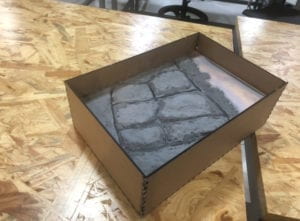

![]()
As for the coding, I use mainly the 64 flame example and change the sample fire picture to a group of looping CyberPunk photos by Liam Wong. As the lights underneath the board flowing randomly with organic color choices, the fireworks made from fiber optic will sparkle and the river will reflect the colors.
Presentation
The basic landscape makes sense to the audience as it is a classic shape of city miniature. However, the fireworks do not work as effective as straight lights will be needed underneath and it is difficult for me to stabilize the location of the strips. Another problem is that I put the platform in the middle depth of the box which I planned to gather the light inside while having the stripes and wires underneath. While presenting, it actually distracts the user experience as they have to bend down to look into the box to get the whole view, and I am also suggested the put the box on the ground as well. Last but not least, I think the order of presenting the object and introduction really matters as the inspiration story really helps the audience to understand the project and lead them into the scene.
Conclusion
Reviewing my project, I would say I paid a lot of attention into the material choices and the producing process of my project in order to make it realistic to the view I am trying to recreate, which brings interior meanings to my project. However, there is a gap between the realism effect and the aesthetic effect and I could have worked more on that by studying more on the outcomes of the stripes and materials I am using. Working with materials I am not familiar with is a big risk, and I don’t have enough backup plans created for it. For the presentation, my choice of the location of the board shows my lack of user tests before the final presenting. It also shows the importance of a more precise design in advance.
Title: Lamp Dodecahedron
Project Description:
For the midterm project, I was inspired by Vincent Buret and his work Mirobolante Light Sculpture. I was especially interested in the shape -dodecahedron and how it is an excellent structure to display light interaction. After doing more research related to this shape, I saw on Pinterest a style of lamp sculptures incorporating light and patterns. Drawing inspirations from these artworks, I decided to create my own dodecahedron lamp using laser cutting and explore further how I can create a project relating this structure to LED light and patterns.
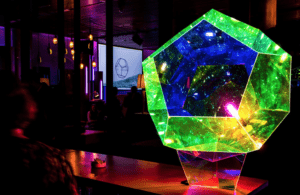 Mirobolante Light Sculpture
Mirobolante Light Sculpture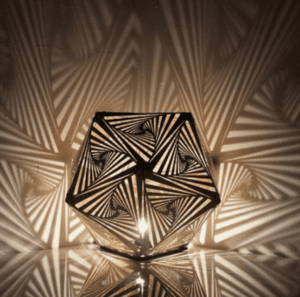 Pinterest Inspiration
Pinterest Inspiration
Perspective and Context
I was really keen on incorporating shapes on sides of the dodecahedron not only because it creates a beautiful visual effect, but also because it connects with Merleau-Ponty’s view on Space in the book “The World of Perception”. He states that our perceived world is structure by a plurality of overlapping perspectives within which different aspects are somehow seen together. As light shine through the geometric shapes, patterns are created in the space. Depending where the viewer stands, where the light is placed, where the reflective surfaces are, people see different patterns. And there is no absolute right way to enjoy it. Any angle provides an unique viewing experience that when they combine together contribute to the greater perception of space.
Development & Technical Implementation
To get started, I decided to use laser cutting as the fabrication method to create the main structure. I drew twelve pentagons in Illustrator and utilized Joinery to create joint inserts. Here are some photos of the first prototype:
In this case, the prototype did not work out because not all the joints match up exactly. I could not assemble the pieces together. It took more spatial imagination to readjust the illustrator file. I also changed to patterns that create better visual effects. The second attempt is shown here:
I learned that acrylic is quite expensive so when prototyping it is best to go with MDF board. I ended up creating a finished prototype by assembling the pieces and making it into a lamp design. It is connected to a 20v halogen light. The results are as pictured:
While the second prototype works well with a stable, bright light source and I was happy with the result, I wanted to do more with LED lights. However, the problem with LED is that lights do not shine through the wood board. In order to best combine LED lights and the structure, I experimented with some alternative materials – reflective glass and frosted acrylic. I ended up picking frosted acrylic as it best presents the effects I want to achieve.
In the process of prototyping, I also tried several different patterns and finalized two distinct patterns for the top and bottom half of the structure.
In terms of the composition, I tried to maximize the functions of digital LEDs by using both single and mixed colors, and control pixels separately to create a kinetic effect. I worked with the fastLED library and built upon some existing light patterns. Here are the details of the code: https://gist.github.com/ivyshi98/73924a12eb95492240b6a8a09d6df956.
Presentation:
For the presentation, I showcased my MDF lamp first. Even though the light effects are limiting with no change of colors, I still thought this piece creates captivating visuals. And people reacted to it quite well even though it was a simple piece.
Then for the main project, I displayed the frosted acrylic lamp on a MDF board with two sides covered. My intention was for each side to reflect the patterns of the lamp. This is a video of the final result:
Both of my works are self-explanatory. In general, people enjoyed the patterns generated by the interaction of LED lights and the lamp as well as the overall light composition. Some of the feedback and critiques include:
1) Create a generative composition – Instead of considering composition with a duration, I should establish a continuous composition that will let people enjoy the display no matter when they see it. It should not have a clear beginning and end. This is something I can definitely improve by adding additional sequences and program the code so that it randomly selects a sequence. The delay time between will also be tuned so it feels more like a transition rather than a sudden stop.
2) Overall display needs improvement – The main critique is that the lamp itself is beautiful but by putting it on a small, plain DMF board it takes away from the effect. The materials do not match and the base is too small to allow the entirety of the pattern reflection to show. Professor Eric suggested using a white foam board. The overall display is definitely lack of consideration on my part. The overall viewing experience is as important as the main sculpture. Next time I will put more time and efforts into testing different display methods and choose the best one. For this project, I re-ran the project near the corner of a dark room. The effects are improved:
Conclusion:
I learned a lot from the process of making this midterm project. In the development stage, it is important to create prototypes and make improvements each time. Do not expect to get to the final product in one go. In addition, it is a good practice to start the prototype small and inexpensive to not waste time and materials. I made the mistake of using acrylic the first time thinking that it will work. After revising my prototype so many times, I now have a good grasp of laser cutting as a fabrication method.
In terms of presentation, I also learned from the critiques and listed the details in the presentation section. Next time, I will consider making a generative composition as well as carefully designing the overall display. A project can be the most beautiful thing but without providing proper display and best viewing angle(s) to the audience, it is worthless.
Description
For this project, I want to imitate the underwater scene using digital led strips and some special materials to make the lights look like water. I have this inspiration from my group assignment where we used glasses of different shapes. I found the globe best distorted the lights and actually magnified the lights and it looked a bit like water. So this time I also want to create something totally like water.
Perspective and Context
Art is about experiencing. My project is to give people the experience similar to what they feel when they are diving into the sea and surrounded by the water. There are all kinds of light and color changes in the marine world. For example, the deeper you dive, the darker the color you will see. Although the installation itself doesn’t move, the different speed of light change will make the illusion that you are actually diving deeper and deeper. This is the relative motion of two sides: the light of the sea and the audience.
And in the World of Perception, the author asserts that the object we perceive is actually its properties. “An object is a system of properties which present themselves to our various senses and which are united by an act of intellectual synthesis” (Merleau-Ponty 59). In my project, I will show the audience the color of the sea, and the texture of water through light modified by a certain material since these two properties can make people immediately relate to the sea.
Development & Technical Implementation
According to the experience of my group assignment on the digital LED light strip, I started to search online for transparent cylinders. At first, I could only find some vases. Then I suddenly recalled that we were suggested to work with acrylic, then I search “transparent acrylic cylinders”, and I found a whole bunch of materials I want.
Then I thought carefully what size of the cylinders I needed before I purchased them. I alsodrew a draft of how I will display the whole sculptural object.

Before the materials arrived, I was trying on the technical part: coding. I used Fadecandy, and it was quite similar to our group assignment. I imported an image I edited, and connect three digital led strips. I also used the Image library to import some small pictures of fish, and wrote the code to make the fish move with my mouse. At first, I wanted to make the moving light dots an actual shape of a fish, but I was told it was not very possible, that the shape will be very vague. So instead, I changed my idea to give the audience an impression that there is some creature swimming by.
The picture I use in Fadecandy to make the light dots the color of the picture when it scrolls down
My code is here: https://gist.github.com/lilyunverwundbar/66d2268a4202890f89c63392674fc6ae
After I received the materials, I started to assemble them together. I used laser cutting to make a wooden box to hide all the wires and breadboard, and a round acrylic lid to place on the cylinders. I glued the cylinders as a big circle and put three strips on the inside of the circle.
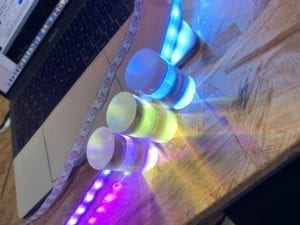 Before gluing: the relection is great
Before gluing: the relection is great
When I finished the physical display, I tried the code and the cylinders reflected the light really well, just likewater. And there is some lines of light diffusing from the connecting point of two cylinders, which was unexpected but very pretty. The audience will have the feeling of seeing underwater views from the outside of the cylinders.
Presentation
Before the class started, I discovered the lights weren’t working. But it worked normally when I placed them on the shelf the day before. I was very anxious then, luckily Professor helped me fixed it, although I had to break the box to check the circuit.
When it was my turn to show the project, my classmates reported that they felt the composition really made them feel underwater, which is good. However, there is some feedback that I could place the object on a white paper to show the lights more clearly. We tried with a small piece of paper and wow it was really beautiful. Also, I can improve more on the physical displaying. Rather than just making one layer of cylinders, I can add more on top to make a pyramid, thus people can also see from the above. For now I am only using an acrylic lid to cover the light strips.
A video of the whole composition:
Some pictures:





Conclusion
This time I did better than the first project. I researched earlier to get proper materials. And I made it look a bit better than last time. But I can still work more on the appearance of the installation, to make it neater, more creative and I should be more daring on the display. Next time I should have more faith in myself and try out different outcomes to choose from. (Like the pyramid displaying of this project which I could try)
My original idea for this midterm project is inspired by the works of Mona Hatoum and Tracey Emin. When I visited Hatoum’s work Hot Spot III at Tate Britan in July 2016, I was fascinated by how light objects affects the environment.
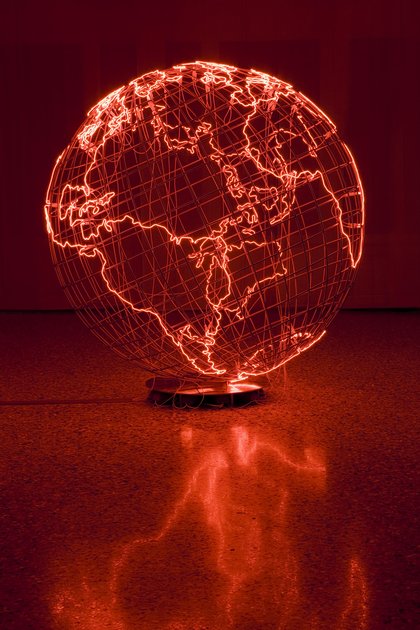
Besides, Tracey Emin’s Neon words installations are also cute to look at.

Based on these works, I intended to construct a prism shape light object. Inside the light object, there would be several words hanging mobiles. The obstacle with this idea is hard to hang the mobiles in the prism. And the idea with words indeed requires serious consideration.
Then my idea totally shifted to another dimension. My capstone is a large glowing box (room). Why don’t I make a small glowing box with more effects? I then laser cut the box first.

I tried with transparent acrylic first, but it would expose the led strips (which I intended to hide). I then tried with the mirroring acrylic to both hide the led strips and better reflect the light.
I then tested with the light.
To both considering the requirement of generative and the glowing idea of my box, I used NeonPixel with Fast LED. It actually took me a lot of time to figure out the color, the gradient and the composition of these three led strips.
I also started with knowing I want to maximize the idea of Glowing. This is one material that my cat really likes to play with, shown as follows:
 In order to make it glow, I cut them to strips:
In order to make it glow, I cut them to strips:


I pasted all the strips onto the box:
 a
a 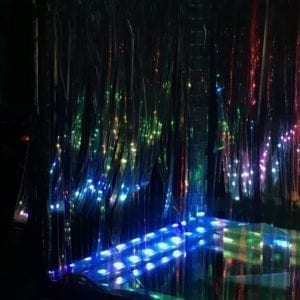 b
b 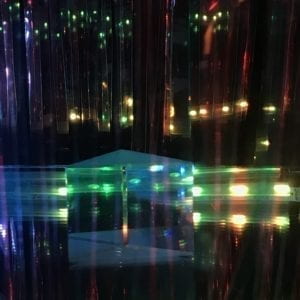 c
c
This is when I was testing with the display. I wanted my audience to walk around from the farther area to a closer area. According to my estimate, people would not be able to see the led strips when they are far away, but only seeing the glowing box. Feeling too hollow with just the change of light, when seeing the box. I thought about the scene in 2001: Space Odyssey, when the ape men discovered the stone tablet, and the stone tablet was a metaphor of civilization.
My idea of wanting people to discover the box is aligned with the film. And I decided to put the phone into the box. And here’s the test:
final show:
1) People’s interaction
2) Documentation:
Professor Eric critiqued this project for the use of the telephone, which was said to have made this project way too complicated than it is best to be. However, I personally enjoy working with symbolism and metaphors. I will leave the question there then.